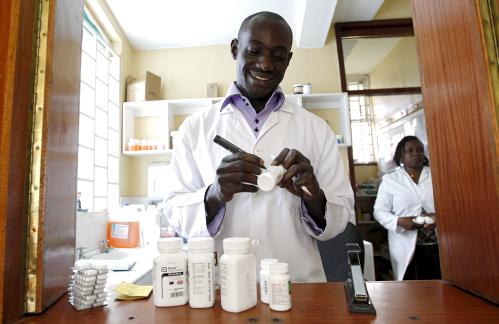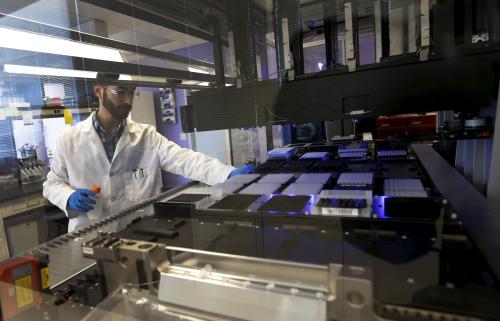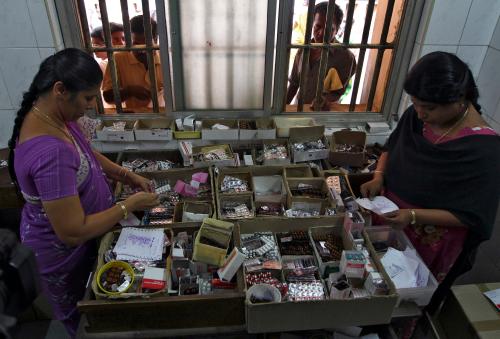When private pharmaceutical companies consider investing in new drugs, they consider profitability: will the new drug generate greater revenue than the research and development (R&D) costs? Our new paper provides a detailed analysis using various incentive mechanisms.
Through previous publications, the Brookings Private Sector Global Heath R&D Project has sought to address the shortfall in private sector investment in global health R&D. Past papers have examined health governance capacity, global health spending levels, and barriers to private sector health R&D. Our new research employs rigorous economic modeling to examine the business case for investing in novel therapies for neglected diseases.
Using an economic analysis, we calculate the return on investment (ROI) for three specific drugs utilizing different incentive mechanisms. The three drugs evaluated are Fexinidazole, Acoziborole and Benzinadozole that ameliorate Chagas Disease and Human African Trypanosomiasis (“HAT”).
Return on investment for various drugs
| OOP clinical costs per investigational drug | Capitalized costs per approved drug | Return on Investment | ||||
| Total | Pre-clinical | Clinical | Total | Current | Restricted | |
| Generic Drug | 339 | 1098 | 1460 | 2558 | -98.4% | -92.2% |
| Generic NTD Drug | 207 | 752 | 1120 | 1872 | -97.9% | -89.3% |
| Fexinidazole | 43 | 32 | 298 | 330 | -88.0% | -39.3% |
| Acoziborole | 55 | 106 | 240 | 347 | -88.5% | -42.3% |
| Benzinadozole | 9 | N/A | 28 | 28 | 41.1% | 610.9% |
Sources: Authors’ calculations, DNDi, DiMasi et al. (2016), and Ridley and Regnier (2016). The estimated PRV value given current market supply is $40 million and estimated PRV value given restricted supply $200 million. OOP refers to out-of-pocket (not capitalized) costs. Costs in million USD.
Four of the five analyses show a negative ROI, meaning the given investment is unprofitable and a pharmaceutical company is unlikely to invest in creating these drugs. The only drug candidate in the study to have a positive ROI was Benzinadozole.
The financial returns considered are based upon the Priority Review Voucher (PRV), a ticket for expedited review of a future drug by the U.S. Food and Drug Administration (FDA). A PRV can result in significant financial returns if the voucher is sold or used to beat a competitor to market, especially on a “blockbuster drug” with annual revenues greater than $1 billion.
We value the PRV using the methodology from Ridley and Regnier (2016) to calculate its economic returns. If 1 PRV is issued per year (“restricted” supply), the value of a PRV was approximately $200 million; likewise, if 4 PRVs were issued, the value fell to around $40 million. Using these values, we calculated the ROI of the three drug candidates.
The economic situation is more optimistic when different probabilities of success are considered. If the probability of success increases to around 30 percent, then both Fexinadazole and Acoziborole will yield a positive ROI (when in conjunction with a PRV and the Orphan Drug Tax Credit).
The paper concludes with two case studies examining the burden of Schistosomiasis and Hookworm. The analysis suggests possible avenues for new research on these two diseases that create positive ROI.
Ultimately, we recommend necessary policy proposals to improve what portents a potential crisis in global health:
- Alignment of public funding with the public benefit
- Private sector late-stage investment and risk sharing
- Public funding coordination and stewardship
- Advanced market commitments for hookworm and schistosomiasis
- Tiered PRV based on social return and clinical stage
- Targeted domestic resource mobilization
With effective implementation of these policy proposals, it may be possible to spur further private investment in global health R&D.
Read the full paper, “Promoting private sector involvement in neglected tropical disease research and development”, here. The authors can be reached at [email protected].
The Brookings Institution is committed to quality, independence, and impact.
We are supported by a diverse array of funders. In line with our values and policies, each Brookings publication represents the sole views of its author(s).









Commentary
Are drugs for neglected diseases profitable?
December 19, 2017